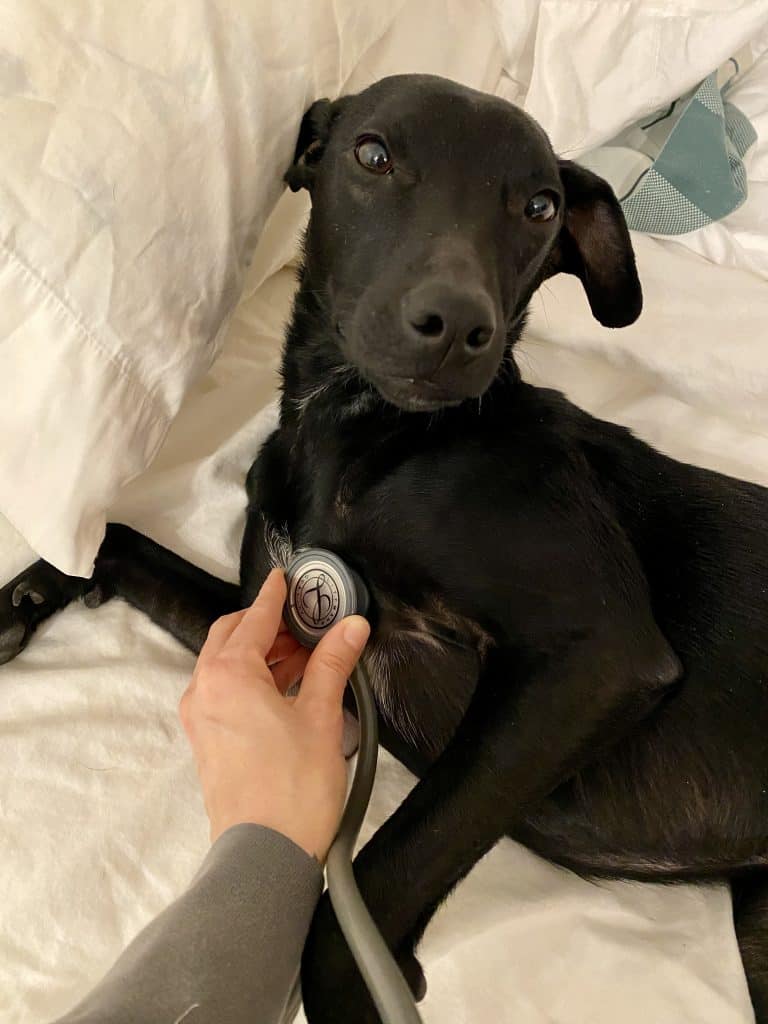If you find yourself asking the question, do vets use stethoscopes? The answer is YES!
Vets use stethoscopes every day when they are checking a pet’s vital signs and auscultating the various internal organs. Learning about a few reasons to become a veterinarian will help you figure out if this science-based career is right for you.
When you first arrive at a vet’s office, either the veterinarian or vet tech will ask you many essential questions about your pet.
These questions will help guide them as to why you are at the vet’s office. Whether you are at the vet’s office for a routine annual exam or your pet is sick, they will usually begin with asking you, the owner, about coughing, vomiting, or diarrhea.
The next step is for the vet to use their stethoscope to listen to the animal’s heart, blood pressure, lungs, and GI tract. Auscultation will help the veterinarian determine if something is wrong. By using a stethoscope, the veterinarian can compare the normal auscultation of the animal versus any abnormalities.
The best veterinary stethoscopes come in various size options. A veterinarian who works with equine will need a stethoscope with a larger head and longer tube. On the other hand, a veterinarian who works with parrots will need a stethoscope with a smaller head. Some stethoscopes are better for small mammals, and some are better for large ones.
The does it all!
During veterinary students’ first year of vet school, they learn the ins and outs of proper stethoscope use. A vet student also learns how a normal heart sounds. Listening to many normal heart sounds is an integral part of picking up the often subtle abnormal sounds or a heart murmur.
Vets Use Stethoscopes Everyday
The Veterinary Tools and Equipment list is long and a stethoscope is an important tool!

It does not matter what type of veterinarian you want to be, you will learn how to properly use a stethoscope during vet school. It takes practice, just like anything else. There are many articles about being a veterinarian on our site. You can read all about what a veterinarian does by checking out some of our other articles.
What do vets listen for with a stethoscope?
Below are just a few of the things a vet listens for when they are diagnosing your pet.
- A stethoscope can help a vet take a pulse on an animal by listening to the beats per minute. Dogs, for example, have varying heart rates depending on the size of the dog. A smaller dog will have a heartrate between 120 and 160 bpm, whereas a larger dog will have a heart rate of 60-120 bpm.
- A vet will listen for systolic heart murmurs with a stethoscope. If they hear a murmur, they may order more tests like bloodwork, Echocardiogram, and chest radiographs.
- Listen to an animal’s lungs with a stethoscope. If a vet hears noises in the lungs, then they may want to do further diagnostic tests. Many different types of continuous and discontinuous lung sounds are picked up by listening.
- Use a veterinary stethoscope to listen to an animal’s gut. A veterinarian may use a stethoscope to listen for hypoactive or hyperactive intestinal sounds. Peristalsis moves things along the bowel tract; this movement should make low grumbling noises heard with a stethoscope. Lack of bowel noises or the wrong noises could be a sign of illness.
A veterinarian can use a stethoscope to help them determine if there is an intestinal blockage. Suppose a veterinarian hears high-pitched sounds and rushing noise s; this might indicate that the intestine has a backup. A jam could be an object or the intestine itself that torqued.
A veterinarian can pinpoint problem areas with the help of a stethoscope. These problem areas can be a first clue and reason to order more tests.
